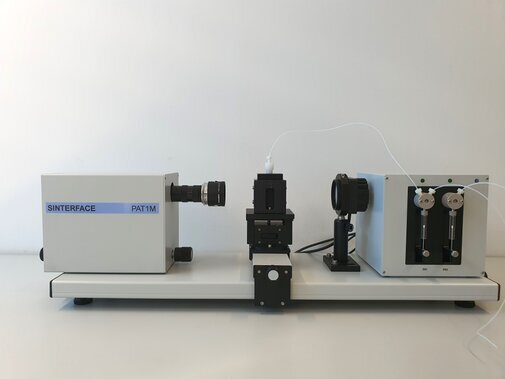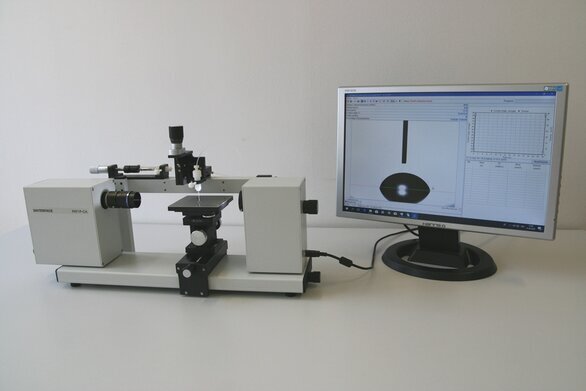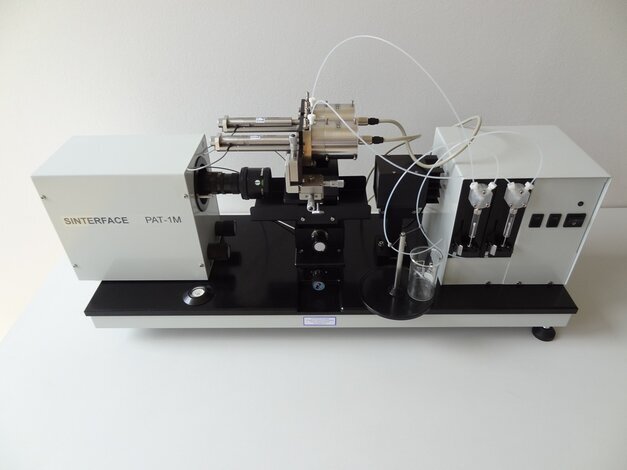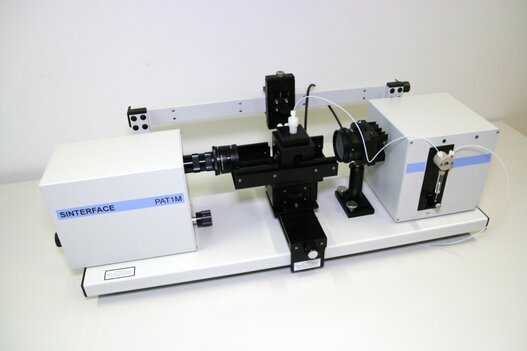Our main expertise is the development of measuring instruments for the characterization of interfaces. One group of instruments is dedicated to measurements of dynamic surface and interfacial tensions. These are the most frequently used methods for characterizing liquid interfaces. Our portfolio comprises of instruments for the maximum bubble pressure (BPA), drop volume (DVA), drop/bubble profile analysis (PAT) and capillary pressure tensiometry (DPA). The PAT is also suitable for contact angle measurements of a liquid drop sitting on a solid surface. Belonging to the classical tensiometry methods, we also provide a ring and plate tensiometer (STA) which is also suitable for measuring the receding/advancing contact angle. In addition we provide instruments for the investigation of the interfacial dilational and shear visco-elasticity, such as slow oscillating drop profile analysis (PAT), fast oscillating drops and bubbles (ODBA) and the interfacial torsion pendulum shear rheometer (ISR). ODBA is additional equipment for PAT. Very recent developments were dedicated to some special equipment, such as the drop volume exchange using a coaxial double capillary with a double dosing system (PAT). Moreover, we have designed a special drop and bubble micromanipulator (DBMM), which is a unique device for mimicking the situations in foams and emulsions by manipulating two drops or bubbles against each other. To better understand foams and emulsions, we designed a liquid film analyzer (TFA) to measure the stability and thickness of foam and emulsions films. A new foam analyzer (FA) is presently in development and will provide the user with a device for characterizing the foamability of a solution, its stability and drainage behavior.
TENSIOMETRY
Profile Analysis Tensiometer PAT2P
Profile Analysis Tensiometer PAT1M
Profile Analysis Tensiometer PAT2S
Maximum Bubble Pressure Tensiometer BPA2P
Maximum Bubble Pressure Tensiometer BPA2S
Tensiometer STA2
Profile Analysis Tensiometer PAT1M
Profile Analysis Tensiometer PAT2S
Maximum Bubble Pressure Tensiometer BPA2P
Maximum Bubble Pressure Tensiometer BPA2S
Tensiometer STA2
CONTACT ANGLE
INTERFACIAL RHEOLOGY
FOAMS AND THIN FILMS
EMULSION CHARACTERIZATION
TENSIOMETRY
Our main expertise is the development of measuring instruments for the characterization of interfaces. One group of instruments is dedicated to measurements of dynamic surface and interfacial tensions. These are the most frequently used methods for characterizing liquid interfaces.
PROFILE ANALYSIS TENSIOMETRY
This tensiometry method goes back to the methodology called ADSA, which was developed by Neumann and his team after the modern video technique became available and computers were powerful enough for managing large computational work in a reasonable time. Now, this method of determining the surface and interfacial tension from the profile of pendent and sessile drops is the most frequently used technique and various commercial instruments are on the market. The drop shape analysis method goes back to the methodology called ADSA, which was developed by Neumann and his team after the modern video technique became available and computers were powerful enough for managing large computational work in a reasonable time. Now, this method of determining the surface and interfacial tension from the profile of pendent and sessile drops is the most frequently used technique and various commercial instruments are on the market.
PAT2P
The drop shape analysis method goes back to the methodology called ADSA, which was developed by Neumann and his team after the modern video technique became available and computers were powerful enough for managing large computational work in a reasonable time. Now, this method of determining the surface and interfacial tension from the profile of pendent and sessile drops is the most frequently used technique and various commercial instruments are on the market.

- Very compact profile analysis tensiometer
- Simple manual instrument to measure surface and interfacial tension of liquids
- Contact angle measurements are available in the basic version
- No power supply needed (powered by USB)
- Ideal instrument for educational purposes
More Information >>
PAT1M
Our PAT1M is based on this methodology and due to its modular architecture, compact design and highly accurate and efficient software it is one of the best instruments of this type worldwide. The process of measurement consists of the image acquisition of the drop/bubble profile, its digitalization and final fitting by the Gauss-Laplace equation. A fully computer controlled dosing system allows to perform pre-programmed measurements with any type of protocol, including constant drop volume or constant drop surface area. Changes of the drop/bubble area according to a given protocol, as it is the case for relaxation experiments, is also possible, i.e. the response of the interfacial layer to harmonic or transient area perturbations can be recorded and hence the surface dilational visco-elasticity determined. The method has many advantages over others, most of all it can be applied to liquid/gas and liquid/liquid interfaces, requires small amounts of liquid, and the temperature control is possible in a rather broad range. Even high temperature experiments are feasible with a special temperature cell.

- High end full automatic profile analysis instrument
- Modern method to measure surface and interfacial tension of liquids
- Interfacial Rheology Studies are available in the basic version
- Modular extensions for different applications
Principle is based on the analysis of the shape of pendent and sessile drops or buoyant and captive bubbles.
Rheological studies are available in the basic version
Well suited to determine the contact angle of liquids on solid surface
Rheological studies are available in the basic version
Well suited to determine the contact angle of liquids on solid surface
PAT2S
The PAT2S is the latest version of PAT instruments and continues the great tradition of PAT1M. The most striking improvements in the newly designed stand-alone tensiometer PAT2S are the higher resolution of the video camera and the more flexible mechanical construction which allows to better adapt the instrument to the requirements of the user. In addition to the higher resolution also high speed cameras with high frame rates is embedded in the corresponding software.

- High end stand-alone full automatic profile analysis instrument
- Modern method to measure surface and interfacial tension of liquids
- Interfacial Rheology Studies are available in the basic version
- Modular extensions for different applications
- Remote control via LAN, WLAN
- Smartphone application for remoute monitoring
- Modern user friendly interface and connectivity simplifies operation of instrument.
Principle is based on the analysis of the shape of pendent and sessile drops or buoyant and captive bubbles
Rheological studies are available in the basic version
Well suited to determine the contact angle of liquids on solid surface
More Information >>
MAXIMUM BUBBLE PRESSURE TENSIOMETRY
The idea of measuring the surface tension from the maximum pressure in a bubble is old, however, the possibility to do this in an accurate way and to receive experimental data over a broad adsorption time interval is rather new. Only by using accurately designed capillaries, accurate and reliable electric pressure sensors, and the proper scientific knowledge on the hydrodynamics of the liquid and aerodynamics of the gas, a correct measurement is possible. The measurement principle is just to determine accurately the pressure change in a bubble during its continuous growth at the tip of a capillary. The maximum of this pressure signal provides the surface tension values for the given liquid.
BPA2P
The BPA2P is a mobile bubble pressure analyzer with a built in computer and storage so that this instrument can even be used off-line in field studies. It determined the hydrostatic component of the measured total pressure automatically so that surface tensions can be easily obtained. The available time range is between 10 ms and about 10 s, with an excellent accuracy and reproducibility.

New developments based on modern hardware and software design expands the instrument’s usability and measurement performances.
New improved compact mechanics increases significantly the reliability and stability of the instrument.
New improved compact mechanics increases significantly the reliability and stability of the instrument.
The touch display, ethernet connection etc.
BPA2S
The BPA2S is the high-end version of our BPA instruments and can provide dynamic surface tensions over a very broad time interval. Based on a particular protocol, proposed by Fainerman in 1990, it is possible to accurately separate the deadtime from the lifetime of a bubble, which allows for dynamic surface tension data in a time interval from less than one millisecond up to about 100 s bubble surface age. This six orders of magnitude time range is possibly the broadest in tensiometry for a single instrument. PAT covers only five orders of magnitude in time when running a measurement over more than a day, while both complement each other to provide a time window from t < 1 ms up to 24 h and more. The possibility of measuring at very short adsorption times allows even studies relevant for fast processes like ink jet printing or fast coating and gives insight into fast processes such as micelle formation/dissolution kinetics.

- High-end maximum bubble pressure tensiometer for precise measurement of surface tension in sub-milliseconds range.
- Stand-alone instrument based on modern hardware and software design with hi-performance embedded computer expands the instrument’s usability and measurement performances.
- Modern user-friendly interface and connectivity simplifies operation of instrument.
Ring and Plate Tensiometry
The ring and plate tensiometry belong to the classical methods for measuring the surface tension of liquids. Due to wetting problems, their use for liquid/liquid interfaces requires a lot of special care and PAT is superior and therefore highly recommended. The principle of this type of tensiometry is to determine the weight of a liquid meniscus formed at a solid body in contact with the liquid. Most frequently rings of a rather thin platinum wire or thin platinum or paper plates are used. A temperature control for the measurement is possible, however, the range is quite narrow due to the required access for the sensible weight measurement. Our STA is based on a standard electronic microbalance, which can then also be used for routine weight measurements.
Coming Soon.....
Drop Pressure Analyzer DPA1
This instrument is an equivalent to the BPA, however, modified such that it can be applied to drops in gas or immersed into a second liquid. This method is the only one that works for the interface between two liquid of the same density (or under microgravity conditions). The method allows measuring the dynamic surface or interfacial tension from about 10 ms up to minutes or hours. For long experimental times, however, a video control is required because the size of the drop should be kept constant during the experiment. Due to the viscosity and inertia effects of the studied liquids, data for adsorption times as short as 1 ms and less, accessible by BPA for the liquid/gas interface, cannot be obtained. The use of the DPA requires a drop profile analysis tensiometer PAT as its concept is to use parts of the PAT for its functionality. A stand alone version is under way so that a PAT as basis is not required.
DPA1
A completely new instrument has been developed for measurements of the dynamic interfacial tensions of solutions in the range of about 50 ms to long times.

Modul Applications
- dynamic interfacial tensions of surfactant solutions
- available time range from less than 50 ms to minutes and hours
- measures also surface tension of liquids
- measures interfacial tension between two liquids of the same density
- dilational rheology with slow deformations
CONTACT ANGLE
The characterization of solid surfaces and liquids play a vital role in understanding adhesion, material wettability, biocompatibility, lubrication of solid surfaces as well as the wetting, spreading, washability and adsorption of liquids. Contact angle and interfacial tension measurements provide the information needed for the development and modification of liquid and solid surfaces. Using various theoretical models, the measured contact angles can be re-interpreted in terms of surface energy contributions. Note, however, this are only differen ways of data interpretation while the really measured quantity is the contact angle itself.
PAT2P-CA
The contact angle is the angle formed by a liquid at the three phase contact line where a liquid, gas and solid intersect. The shape of the drop is controlled by the three forces of interfacial tension shown in the figure. The contact angle is a quantitative measure of the wetting of a surface by a liquid. It can as well be used as a control measure in surface treatment and cleanliness.

INTERFACIAL RHEOLOGY
When interfacial layers are deformed there are forces acting against this deformation. There are principally two forms of deformation:
- shear deformation: changing the shape of the interface at constant area
- dilational deformation: keeps the shape constant but changes the surface area.
The possibility of expanding and compressing an interfacial layer is a peculiarity different to bulk rheology, where in a first approach the incompressibility of liquids is assumed.
Interfacial Dilational Rheology with PAT1M and PAT2S
Both profile and capillary pressure analysis tensiometers are suitable also for measuring the dilational rheology by means of area perturbations. While PAT allows for low frequency oscillations up to a maximum of 0.2 Hz, the oscillating drop and bubble capillary pressure analyzer ODBA allows studies of the dilational visco-elasticity at much higher frequencies. For the water/air interface oscillation frequencies of 100 Hz and more are feasible. For water/oil interfaces, due to viscosity and inertia effects, much lower frequencies are feasible and the limits have to be determined for each pair of liquids.

A typical dilational experiment can be carried out with our automatic drop shape tensiometers PAT. Using the dosing system the drop area can be subjected to transient or harmonic perturbations:
Oszillating Drop and Bubble Analyzer ODBA1M
The use of small spherical drops allows oscillation at much higher frequencies as it is accessible with the PAT technique. This is true due to decreased impact of inertia on the drop oscillation modes, which are expected to oscillate in a more or less radial way. As soon as additional (wobbling) modes come into play, the limits of this technique are reached. Unfortunately, there is not a single control parameter available as in PAT measurements to test the physically reasonable frequency limit. Only a general trend can be clearly seen: the smaller the drop and the smaller the amplitudes of oscillation are, the higher are the frequencies for physically reasonable experiments. A real test of this frequency limit would require experiments with liquid systems in absence of any surface active molecules, including possible impurities in the studied liquids.

This instrument is designed as an additional module for the PAT1, PAT1M and PAT2S, using the temperature control chamber, optical bench, light source and video image acquisition for the alighnment, focusing and determination of the drop size. If drops have a spherical shape (very small and/or low density), the measurement of the pressure P together with the radius of curvature r yields the interfacial tension y.
More Information >>
More Information >>
Interfacia Shear Rheology
In addition to dilational rheology, our interfacial shear rheometer ISR provides the shear rheology of interfacial layers. Due to the applied principle of a torsion wire pendulum it is very sensitive and can probe structure formation at interfaces with very low shear visco-elasticities.

FOAM ANALYSIS

The properties of foams formed from a certain surfactant or polymer solution cannot be forecasted from knowing the solutions surface properties. Even knowledge on respective foam films is not sufficient to know in advance the final foam behavior. Therefore, a direct characterization of real foams is essential for many applications. The principle of the FA is different from all other existing foam instruments. Although the foam generation is made in a standard way by pressing gas into a solution through a porous glass frit, the analysis of the produced foam is different from other instruments. The FA has two sets of sensors for measuring foamability, stability and drainage, one being an electric conductivity and the other an optical sensor. For transient foams which are not very stable, the instrument provides mainly the foam volume as a function of injected gas volume. For very stable foams the application of a partial vacuum to the foam column accelerates the drainage and the foam breaks down. This strategy make a quantitative analysis of a foam possible which otherwise would be stable even over days.
THIN FILM ANALYSIS

Thin films are the main elements of a foam or emulsions and therefore a characterization of their main properties, i.e. the thickness and the stability, is essential. The TFA provides such measurements. The thickness of foam films is measured by an interferometric method. The stability studies are done with the same and via a camera mounted to the used inverse microscope the process of film thinning, the appearance of black spots and black films can be recorded.
EMULSION CHARACTERISATION
At present, we do not provide yet an instrument for direct studies of the main emulsion properties. The concept of our DBMM1, however, allows mimicking the situation in foams and emulsions, i.e. mimics the contact of two bubbles or two drops in a respective liquid medium. Also asymmetric systems like interaction of a drop and a bubble can be studied. Combined with our fast video technique HSC it is feasible to study the coalescence process between drops and/or bubbles in real time, i.e. on the scale of microseconds.






